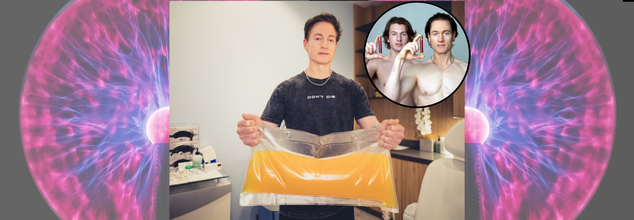- Health Conditions A-Z
- Health & Wellness
- Nutrition
- Fitness
- Health News
- Ayurveda
- Videos
- Medicine A-Z
- Parenting
- Web Stories
Blood Cancer Awareness Month: Key Signs And Symptoms To Watch For

Blood Cancer (Credit: Canva)
Blood cancer is the fifth most common type of cancer, killing over 7,20,000 people globally each year, according to GLOBOCAN. Also known as hematologic cancer, it targets the blood-forming tissues or immune system cells, disrupting the body's ability to produce healthy blood cells. As we mark blood cancer awareness month in September, here is how you can identify it.
Are There Types Of Blood Cancer?
Blood cancer is of three main types: leukaemia, lymphoma, and myeloma.Leukaemia affects the blood-forming tissues, such as the bone marrow and lymphatic system, leading to the overproduction of abnormal white blood cells.
Lymphoma involves cancer of the lymphatic system and is categorized into Hodgkin lymphoma and non-Hodgkin lymphoma. This type of cancer impacts the lymph nodes and other lymphatic tissues.
Myeloma, particularly multiple myeloma, involves the cancer of plasma cells in the bone marrow, affecting the production of blood cells and antibodies.
Here's How You Can Identify Blood Cancer
Common signs include persistent fatigue, frequent infections, and unexplained bruising. Patients may also experience unexplained weight loss, lumps or swelling, night sweats, recurrent infections, and unexplained fever. These symptoms can vary widely but often signal the need for further medical evaluation.Treatments For Blood Cancer
- Chemotherapy: Uses drugs to kill cancer cells or stop their growth.- Radiation Therapy: Employs high-energy radiation to target and destroy cancer cells.
- Targeted Therapy: Focuses on specific molecules involved in cancer cell growth to interfere with their function.
- Stem Cell Transplants: Replaces damaged bone marrow with healthy stem cells to restore blood cell production.
Biohacker Bryan Johnson Swaps Out His Plasma To Reverse Aging; How Does It Work?

With new longevity science and health experiments, there is one individual at the forefront, Bryan Johnson, a tech billionaire-biohacker with a passion for reversing the clock. Renowned for spending more than $2 million a year on his own personal anti-aging routine, Johnson has pushed his crusade to new limits by having total plasma exchange (TPE)—a scientifically fascinating but highly controversial treatment that replaces the body's plasma with a substitute solution in an attempt to purify the body and, in Johnson's desire, reverse the clock.
Johnson, 47, was formerly in the headlines for injecting himself with his teenage son's plasma as part of what he called a "multi-generational plasma exchange." This was captured during the Netflix special Don't Die, which followed his extensive anti-aging trials, including plasma swapping with his father and son.
But as Johnson recently posted on social media, he has since switched from that headline-making habit. "I didn't give up because injecting your child's blood is creepy. I gave up because there's something that works better," Johnson tweeted.
That "something" is total plasma exchange (TPE)—a clinical-level process commonly compared to an "oil change" for the human body.
What Is Total Plasma Exchange?
Also referred to as therapeutic plasma exchange, or plasmapheresis, TPE is a procedure where the blood from a patient is taken out, broken down into its components (red cells, white cells, platelets, and plasma), and then the plasma is removed and replaced with a replacement fluid like albumin or donor plasma. The replacement fluid and the blood cells are then injected back into the body of the patient.
Having been used in hospitals for decades, TPE is already approved for conditions such as Guillain-Barré syndrome, myasthenia gravis, lupus, vasculitis, and even long COVID. New research now suggests that it has the potential to contribute to anti-aging, mental clarity, and immune system restoration—a path Bryan Johnson is heavily invested in.
What Happens When The Plasma Is Removed From Your Body?
Johnson's TPE treatment, as described by him, is to take out all his plasma and put in a 5% albumin solution and IVIG (intravenous immunoglobulin)—an extremely potent antibody-infused fluid usually reserved for bolstering or modulating immune function in immunocompromised individuals.
His treatment follows a bi-weekly routine involving two plasma exchange sessions, and then IVIG infusions that are four days apart. For each session, Johnson's team takes extensive baseline measurements, ranging from toxin concentrations to organ age to even microplastic levels.
In an interesting twist, Johnson asserts that his plasma was so exceptionally pure—presumably because of his stringent vegan diet, sleep habits, and supplement protocol—that the medical technician running the TPE machine "couldn't bring himself to throw it away."
What Is Albumin?
Albumin is the most prevalent protein found in human blood plasma. It has a primary function in tissue repair, transportation of nutrients, and fluid regulation. In TPE, it's the primary replacement fluid because it's compatible with human physiology and has a supporting role to preserve normal body functions after plasma removal.
Johnson feels that substituting his plasma with albumin provides a more efficient way of removing "unnatural pollutants" from the body—something that he believes is crucial in lowering biological age and avoiding age-related disease.
How Plasma Exchange Fights Aging?
The theoretical attraction of plasma exchange among longevity communities is that it has the ability to eliminate pro-inflammatory factors, toxic proteins, and defective antibodies that accrue over aging. Mice studies have established that the elimination of old plasma can trigger rejuvenation of organs and improved cognitive function—inspiring hopes for the same in humans.
According to proponents, removing plasma and replacing it can:
- Reduce systemic inflammation
- Enhance metabolic function
- Increase energy and mental acuity
- Boost immune system strength
While the area has not yet seen large-scale human studies, preliminary data and anecdotal results, like those of Johnson, are fueling increasing interest in TPE as a research anti-aging intervention.
TPE isn't for the faint of wallet. The cost of each session ranges from $5,000 to $10,000, and insurance usually doesn't cover the treatment unless it's for a condition approved by their organization. Johnson, who cashed out his payment firm Braintree to PayPal for $800 million, can finance his curiosity—and he's doing it on a very public platform.
Side Effects and Risks of Plasma Exchange
As with any surgical procedure, TPE has its own risks and side effects, which include:
- Fatigue and nausea
- Tingling of the hands, feet, or lips
- Risk of low blood pressure, low calcium, or anemia
- Occasional complications such as bleeding, infection, or syncope
Because it is a complex procedure, it needs experienced professionals and sterile equipment—the procedure is usually done in specialized hospitals or clinics.
How Does It Add To Longevity?
While Bryan Johnson’s approach might seem extreme to some, it’s pushing the boundaries of what modern medicine knows about aging and regeneration. Whether plasma exchange will emerge as a validated fountain of youth or remain a fringe biohacking trend remains to be seen.
Johnson, though, is convinced the proof is "emergent" and that his protocol could revolutionize our conception of aging. "I now have a birthday every 19 months," he asserts, quoting a deceleration of his biological aging rate to only 0.64, based on measurements taken by his team.
Johnson’s journey—from son-to-father blood swaps to high-tech plasma exchange—may seem eccentric, even controversial. But it shines a spotlight on a fundamental question facing medicine and humanity alike: What if aging isn’t inevitable?
His approach may not yet be mainstream or universally accepted, but it's certainly forcing a larger conversation about the future of personalized medicine, regenerative therapies, and how far we’re willing to go in pursuit of youth.
Long COVID 'Brain Fog' Linked To Inflammation, Stress Markers: Study

Credit: Canva
A recent study has provided the first concrete evidence linking the debilitating "brain fog" experienced by millions of long COVID patients to changes in the brain, including inflammation and a compromised ability to rewire itself after infection.
The small-scale study, conducted by researchers at Corewell Health in Grand Rapids, Michigan, and Michigan State University, found that alterations in two key brain chemicals could be driving these cognitive issues, according to United Press International. The research is particularly significant as it offers scientific validation for the approximately 12 million long COVID patients in the United States who have reported neurological symptoms without prior medical proof.
Researchers examined biomarkers in 17 COVID-19 patients, including 10 who still experienced symptoms six months after contracting the virus. Participants who reported brain fog exhibited elevated levels of an anti-inflammatory protein critical to regulating the immune system and lower levels of nerve growth factor (NGF), a protein essential for the brain’s plasticity.
Brain plasticity refers to the organ’s ability to adapt, reorganize, and heal itself following illness or injury. The National Library of Medicine explains that this process involves the brain adjusting its structure, functions, or connections to accommodate changes brought on by conditions like long COVID.
One of the study's co-authors, Dr. Bengt Arnetz, emphasized the importance of the findings. “We found biological changes, which I think is a very big strength for this study,” he said. He added that the suppression of NGF in long COVID patients is consistent with findings from neuro-cognitive tests.
During the study, participants underwent various psychological assessments, with most tests showing unremarkable results except for the "letter fluency" test, which measures executive functioning under time constraints. Clinical neuropsychologist Michael Lawrence, another co-author, explained that the test involves generating words starting with a specific letter or naming items within a category, such as fruits or animals. Participants with long COVID struggled more with this task, suggesting impairments in executive function, memory, and language.
Lawrence noted that the results provide objective findings that align with the symptoms long COVID patients have been reporting. “Now we have some objective findings that really confirm what patients are describing and feeling,” he said.
Identifying these biomarkers could aid in developing targeted, multidisciplinary treatments for long COVID symptoms, Lawrence added. He emphasized the need for a holistic approach to treatment, noting that addressing mental health symptoms can also alleviate physical symptoms like pain and fatigue. "We really need to treat the whole person, but we need to treat it early," he said.
Salt, Stress And Screens: The New Triggers Of High Blood Pressure

Hypertension has long been a quiet predator, usually symptom-free until it causes severe damage to health. Popularly referred to as the "silent killer," high blood pressure is no longer limited to genetic history, poor eating habits, or couch potatoes. With today's hyper-connected, high-pressure lifestyle, new culprits have joined the scene: excessive salt, chronic stress, and screens. The modern-day triggers are quietly but emphatically raising blood pressure in individuals of all ages—even young adults.
This segment discusses how these apparently disparate lifestyle variables overlap, lead to hypertension, and what world health officials are saying about addressing this plague as a whole. Historically, hypertension was associated with age, weight, or inactivity but by experts' accounts the scene has dramatically altered, let's see.
Modern Triggers Of Hypertension
“With changing lifestyles, we’re witnessing hypertension driven by urban stressors- excessive salt intake, ongoing psychological stress, and extensive screen exposure. These risk factors are no longer isolated but compounding and overlapping, especially in city dwellers,” says Dr. Anjan Siotia, Director, Cardiology, BM Birla Heart Hospital Kolkata,
What's worrying is that these triggers tend to be ignored or accepted as part of contemporary living. But the harm they cause is not so subtle either. Chronic high blood pressure raises the risk of heart attacks, strokes, kidney damage, and even dementia.
Salt
Salt is a vital nutrient that supports muscle contraction, fluid balance, and blood pressure. But excessive amounts? Trouble starts there. Clinical Dietitian and Reenurture Founder Reena Poptani describes how the average adult's salt consumption exceeds guidelines.
"WHO advises less than 2000mg per day (about 5g of salt), while the American Heart Association advises that it should be restricted to 1500mg for those at risk. But all of us unknowingly take two to three times the amount—mainly in the form of packaged foods and processed foods," she informs.
Sneaky sodium is hiding in popular favorites such as chips, instant noodles, ketchup, bread, mayonnaise, pickles, and frozen foods. Monosodium glutamate (MSG), sodium nitrate, and sodium benzoate are also high-sodium preservatives to add shelf life but damage heart health.
"It's not merely the salt you can see sprinkled over food," says Reena. "The true danger is in the salt that isn't visible. Cutting back this invisible sodium is a huge leap toward lowering blood pressure levels."
She recommends simple measures such as eschewing table salt, adding flavor with spices and lemon, opting for fresh fruits and vegetables rather than frozen or packaged ones, and reading labels carefully. Even modest decreases in sodium consumption can result in significant declines in blood pressure.
Stress
Stress was once thought to be episodic—a reaction to unexpected difficulties. Now, it's chronic, relentless, and intertwined in the texture of everyday living. Money concerns, job overload, social comparisons, and individual uncertainty all feed into this persistent mental tension.
Raee Sharma, Associate Clinical Psychologist, Lissun, describes the psychological school of thought:
"When the body is under extended stress, the body is stuck in fight-or-flight mode. This results in stress hormones such as cortisol and adrenaline remaining high, raising heart rate and causing blood vessels to constrict, eventually resulting in ongoing hypertension."
But stress does not work all on its own. It also fuels negative coping habits: eating junk food, smoking, drinking alcohol, inadequate sleep, and withdrawal from social interactions. These all degrade blood pressure, so stress is a multi-pronged foe.
Raee mentions an alarming trend among her clients, "Many are unaware of how their unresolved emotional issues—burnout, anxiety, even emotional suppression—are translating into physical symptoms like fatigue, irritability, and high blood pressure. We must address these mental stressors head-on.
Her tip? Cultivate emotional awareness. Know how to spot signs of overwhelm in the bud. Practice therapeutic techniques—be it mindfulness, talk therapy, journaling, or relaxation training. Building psychological safety nets can preclude physical breakdown.
Screens
Our screens are a lifeline these days, linking us to work, social life, and entertainment. But too much comes at a heavy cost. Too much screen time is now being linked to hypertension, especially among children and young adults. Here's what Dr. Siotia says:
“More screen time equates to less physical movement, which contributes to weight gain and poor cardiovascular health. Add to that the overstimulation and sleep disruption from devices, and we’re looking at a perfect storm for elevated blood pressure.”
Raee Sharma echoes this concern, emphasizing three major risks of screen overuse:
Physical Inactivity: Hours in front of screens replace time that could be spent moving or exercising.
Sleep Disturbance: Blue light reduces melatonin levels, making it more difficult to sleep and remain asleep.
Cognitive Fatigue: Ongoing exposure to bad news, social media, and electronic noise continues to overstimulate the brain, raising stress levels.
"Most people don't even know they're so emotionally drained from their digital existence. It keeps their nervous system in high gear, quietly elevating their blood pressure every day," Sharma states.
There must be boundaries set in the digital world. Balance is suggested by Raee through screen-free evening time, offline pursuits, nature strolls, and intentional limits on doomscrolling.
Holistic Blueprint to Beat Hypertension
2025 means more than prescription medication or annual checkups to treat hypertension. What's needed is a lifestyle reboot—involving nutritional well-being, emotional wellbeing, and thoughtful use of technology.
A multi-faceted action plan is drawn up by Dr. Siotia
- Check blood pressure on a regular basis, particularly if you have a family history or have a stressful lifestyle.
- Engage in 30 minutes of exercise every day, whether it is walking, cycling, or yoga.
- Avoid tobacco and excessive alcohol consumption, both of which increase blood pressure.
- Take sufficient sleep, preferably 7–8 hours, so that the body can rest.
- Practice mindfulness or meditation to handle chronic stress.
Reena Poptani adds, “Reducing salt gradually—not drastically—helps retrain the palate and makes healthy eating sustainable.”
Raee Sharma encourages emotional check-ins, “If you’ve been feeling ‘off’—irritable, anxious, or constantly fatigued—don’t ignore it. Psychological stress often shows up in the body long before the mind registers it.”
Salt, stress, and screens appear to be isolated strands, but they are deeply entangled in the tapestry of contemporary existence. And as our ways of living increasingly move toward convenience, haste, and dependency on devices, the influence on our blood pressure becomes increasingly inescapable.
In order to actually treat hypertension today, we need to advance our comprehension. It's not merely a matter of physical health—it's emotional, it's behavioral, it's environmental.
Let's not wait for a diagnosis to begin making choices. Whether it's trading your salty snack for a fruit bowl, writing in your journal rather than scrolling, or just taking a deep breath after a stressful meeting—each mindful decision contributes because in the battle with the silent killer, awareness, intention, and action are our best allies.
© 2024 Bennett, Coleman & Company Limited

